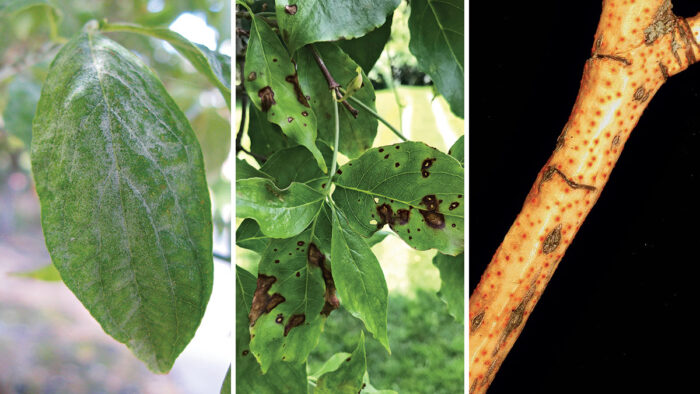
Like many woody plants, dogwoods can be afflicted by disease. Fortunately, when correctly identified, most diseases can be treated with little fuss. See The Best Dogwoods for Your Garden.
Powdery mildew
Symptoms: Starting in late spring, dark, irregularly shaped, reddish brown spots appear that can enlarge and coalesce over time. Eventually, white mycelial patches form. Marginal and stem necrosis develops.

Impacted species: C. florida is by far the most susceptible, while C. kousa is more resistant. C. officinalis and C. alternifolia are highly resistant. Most of the shrub species are moderately susceptible, with variegated clones seemingly more susceptible in areas with stressful summer conditions.
Conditions: Poor air circulation; moisture (drought) stress; accumulation of infected leaves on the ground around susceptible plants
Recommended actions: Regularly remove all fallen debris beneath infected plants, and burn or bag it. Do not compost infected debris. Prune densely branched plants to improve airflow. Through hot-and-dry months, provide adequate irrigation (use drip instead of overhead to minimize water droplets on leaves in the evening). Plant in partial shade to reduce drought and heat stress to plants. Plant resistant varieties.
Anthracnose

Symptoms: Spring leaf spots with tan centers and purple-to-red/ brown margins appear. Necrosis to leaf margins and tips develops, followed by petiole and stem dieback. Advanced cases display significant visible shoot necrosis and sprouting of shoots at the base of the tree.
Impacted species: C. florida is most susceptible, followed by C. nuttallii (one of the parents of Venus®) and C. kousa. Species such as C. amomum, C. alternifolia, C. officinalis, C. mas, and C. sanguinea seem to be quite resistant.
Conditions: Poor air circulation; areas with cool, damp springs
Recommended actions: While there are fungicidal treatments that can lessen symptoms, the best treatment is to plant resistant varieties. Of flowering dogwoods, the most resistant cultivars seem to be those in the Appalachian series, particularly ‘Appalachian Spring’. The others in the series all seem to be above average in anthracnose resistance. Fungicide applications at three-to-four-day intervals during leaf emergence can be effective at preventing the disease.
Golden canker

Symptoms: Sunken patches of tan to bright orange (gold) appear on branches. Branch dieback usually occurs above canker.
Impacted species: C. alternifolia
Conditions: This one is a bit of a mystery. Drought-stressed plants seem more susceptible, and physical damage to bark may provide an entry point for fungal infection.
Recommended actions: Golden canker rarely kills whole plants. Prune away diseased branches. In severe infection cases, cut the plant all the way to the ground and allow it to resprout.
Dogwood botryosphaeria canker

Symptoms: Dark or sunken lesions appear on stems, usually at the plant base. As lesions enlarge, they can encircle and girdle stems, causing whole stem dieback.
Impacted species: Most prevalent on shrub species C. sericea and closely related C. alba, while C. amomum and C. sanguinea are far less susceptible.
Conditions: Drought and heat stress increase potential for canker formation. The thin bark of these species makes them highly susceptible because it is easily damaged by culprits such as string trimmers and lawn mowers.
Recommended actions: Avoid heat and moisture stress, and eliminate physical damage to thin bark. This disease rarely kills plants. Prune out infected branches with disinfected pruners. In severe cases, cut the plant all the way to the ground and allow it to resprout.
Paul E. Cappiello, Ph.D., is the executive director of Yew Dell Botanical Gardens in Crestwood, Kentucky, and a co-author of Dogwoods: The Genus Cornus.


















Comments
Log in or create an account to post a comment.
Sign up Log in